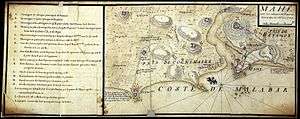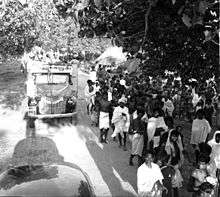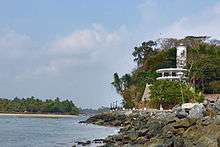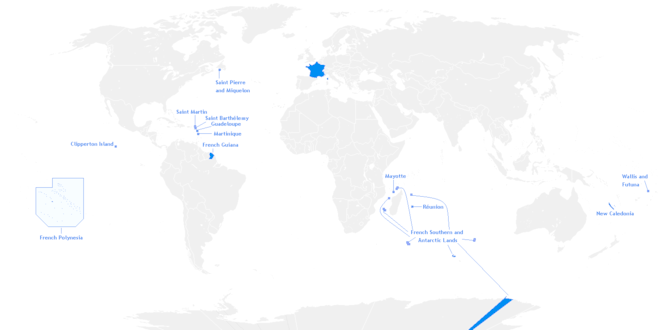Mahé, India
Mahé, also known as Mayyazhi, is a small town in the Mahé district of the Pondicherry Union Territory. It is situated at the mouth of the Mahé River and is surrounded by the State of Kerala. The Kannur District surrounds Mahé on three sides and Kozhikode District from one side.
Mahé Mayyazhi | |
|---|---|
District in Puducherry, India | |
 Mahé Location of Mahe surrounded by Kerala  Mahé Mahé (India) | |
| Coordinates: 11°42′4″N 75°32′12″E | |
| Country | India |
| Union Territory | Puducherry |
| District | Mahé |
| Government | |
| • Type | Municipality |
| • Body | Mahé Municipality (Mairie de Mahé) |
| Area | |
| • Total | 9 km2 (3 sq mi) |
| Population (2011) | |
| • Total | 41,816 (approx) |
| • Density | 4,646/km2 (12,030/sq mi) |
| Languages | |
| • Official | Malayalam, English |
| • Additional | French |
| Time zone | UTC+5:30 (IST) |
| PIN | 673 310 |
| Telephone code | 91 (0) 490 |
| Vehicle registration | PY-03 |
| Sex ratio | 1,000 ♂/1,184♀ |
| Literacy | 97.87% |
| Vidhan Sabha constituency | 1 |
| Climate | Tropical monsoon climate (Köppen) |
| Website | mahe |
Formerly part of French India, Mahé now forms a municipality in Mahé district, one of the four districts of the Union Territory of Puducherry. Mahé has one representative in the Puducherry Legislative Assembly.
Etymology
The name Mahé derives from Mayyazhi, the name given to the local river and region in the Malayalam language. The original spelling found on French documents from the early 1720s is Mayé, with Mahé and Mahié also found on documents, maps and geographical dictionaries until the early 19th century when the spelling Mahé became the norm. Therefore, the belief that the name of the town was given in honour of Bertrand François Mahé de La Bourdonnais (1699–1753), whose later fame derived in good part from his association with India, including his capture of Mayé in 1741, is incorrect.[1]
Another claim that the spelling Mahé was officially adopted by the leader of the expedition that retook the city in 1726 in recognition of La Bourdonnais' role at the time is also unlikely.[2] It is probable that the resemblance of Mayé, not to mention Mahé, with La Bourdonnais' family name prompted later generations to assume that the famous Frenchman was somehow directly or indirectly associated with the name to the town or the spelling of the name.
History
Before the incursion of European colonial powers into India, this area was part of Kolathu Nadu which comprised Thulunadu, Chirakkal and Kadathanadu. The French East India Company constructed a fort on the site of Mahé in 1724, in accordance with an accord concluded between André Mollandin and Raja Vazhunnavar of Vatakara three years earlier. In 1741, Mahé de La Bourdonnais retook the town after a short period of occupation by the Marathas.
In 1761 the British captured Mahé, and the settlement was handed over to the Rajah of Kadathanadu. The British restored Mahé to the French as a part of the 1763 Treaty of Paris. In 1779, the Anglo-French war broke out, resulting in the French loss of Mahé. In 1783, the British agreed to restore to the French their settlements in India, and Mahé was handed over to the French in 1785.[3]

On the outbreak of the French Revolutionary Wars in 1793, a British force under James Hartley captured Mahé. In 1816 the British restored Mahé to the French as a part of the 1814 Treaty of Paris, after the conclusion of the Napoleonic Wars. Mayyazhi remained under French jurisdiction as a small French colony, an enclave within British India, during the long span that began in 1816. After the Independence of India the area continued to be French-ruled until 13 June 1954, when a long anti-colonial struggle culminated in its joining the Indian Union (see Causes for liberation of French colonies in India).
After the French left, Mahé became a district of Puducherry Union Territory. The area of Mahé begins from Mayyazhi puzha in the north to Azhiyoor at the south. Mahé consists of Mahé town and Naluthara, which includes four villages: Pandakkal, Pallur, Chalakara and Chembra. The ruler of Kingdom of Mysore from the 1760s, Hyder Ali (ca 1722–1782), gifted Naluthara to the French as a token of appreciation for the help they gave in opposing the British.
Liberation of Mahé
Gandhians like I. K. Kumaran led the freedom struggle in Mahe after Indian independence in 1947. The Municipal office of the French administration was attacked on 21 October 1948 at 9:00 PM. The French national flag was removed and the Indian national flag hoisted on the Municipal Building (Mairie in French). On 26 October, a French navy ship anchored in Mahe and the French regained control of Mahe. The ship left Mahe on 31 October. Communists tried to capture Cherukallayi enclave in April 1954. Two Indians were killed during the struggle. The Indian flag was hoisted in the Naluthura enclave on 1 May. The freedom fighters conducted an embargo on Mahe from June that year. On 14 July 1954, the Mahajanasabha organized a March into Mahe and Mahe was liberated on 16 July 1954.[4][5]

Demographics
As of 2011 India census,[6] Mahé had a population of 41,816, predominantly Malayalis. Males constitute 46.5% of the population. Mahé has an average literacy rate of 97.87%; male and female literacy were 98.63% and 97.25%, respectively. In Mahé, 10.89% of the population consists of children under six years of age.
Locationwise distribution
- Mahe 10630
- Chalakara 6855
- Pandakal 8944
- Palloor 14250
- Cherukallayi 1255
Culture
The culture and geography of this area are like almost all of those in the Malabar Coast of Kerala. The major festival of this region is Vishu and Onam and Eid. The major language is Malayalam. The population also includes Tamil and Arabic speakers.
Climate
Mahé has a tropical monsoon climate (Köppen Am), typical for the Kerala and Karnataka coast. There is a dry season from December to March, but the location on the windward side of the Western Ghats means that during the westerly monsoon season the region receives exceedingly heavy rainfall, reaching up to 1,080 millimetres or 43 inches in July.
| Climate data for Mahé, Puducherry, India | |||||||||||||
|---|---|---|---|---|---|---|---|---|---|---|---|---|---|
| Month | Jan | Feb | Mar | Apr | May | Jun | Jul | Aug | Sep | Oct | Nov | Dec | Year |
| Average high °C (°F) | 31.6 (88.9) |
32.0 (89.6) |
33.0 (91.4) |
33.2 (91.8) |
32.7 (90.9) |
29.6 (85.3) |
28.3 (82.9) |
28.7 (83.7) |
29.5 (85.1) |
30.4 (86.7) |
31.0 (87.8) |
31.4 (88.5) |
31.0 (87.8) |
| Average low °C (°F) | 21.8 (71.2) |
22.9 (73.2) |
24.6 (76.3) |
25.8 (78.4) |
25.7 (78.3) |
23.9 (75.0) |
23.4 (74.1) |
23.6 (74.5) |
23.7 (74.7) |
23.8 (74.8) |
23.3 (73.9) |
22.0 (71.6) |
23.7 (74.7) |
| Average rainfall mm (inches) | 3 (0.1) |
4 (0.2) |
13 (0.5) |
76 (3.0) |
295 (11.6) |
905 (35.6) |
1,083 (42.6) |
539 (21.2) |
274 (10.8) |
237 (9.3) |
106 (4.2) |
22 (0.9) |
3,557 (140) |
| Source: Climate-Data.org[7] | |||||||||||||
Transport
Mahé's nearest airport is the recently commenced Kannur International Airport, Mattannur, at a distance of 40 kilometres (25 miles). The next nearest airport is the Calicut International Airport, Karipur, at a distance of 85 kilometres (53 miles). The nearest Railway Station is Mahe railway station, where a few local and express trains stop. The nearest major railway stations, where several long distance trains stop, are Thalassery, Kannur, Mangalore and Vatakara.
Administration
Mahé Municipality is the seat of the local administration of Mahé. The Mahé municipal area comprises 9 square kilometres (3.5 square miles) with one Assembly Constituency, i.e. Mahé. Municipal Council was not in existence with effect from 1978. Thereafter, the Regional Administrator or Regional Executive Officer used to exercise the power of the chairman and Vice-Chairman in the capacity of Special Officer of Mahé Municipal Council. Civic elections were held during 2006 after nearly 30 years. Based on the elections, the chairman and 15 councillors of Mahé Municipality were sworn in.
Divisions
- Mahé Town
- Cherukallayi
- Chalakkara
- Chembra
- Palloor
- Pandakkal
Wards
Mahé Municipality consists of 15 wards.
Mahé Pocket
- Mundock
- Manjakkal
- Choodikotta
- Parakkal
- Valavil
Naluthara Pocket
- Pandakkal North
- Pandakkal Central
- Pandakkal South
- Palloor North-East
- Palloor North-West
- Palloor South-West
- Palloor South-East
- Chalakkara North
- Chalakkara South
Cherukallayi Pocket
- Cherukallayi
Education
Mahatma Gandhi Government Arts College in Mahé, was established in the year 1970 by I K Kumaran. The Mahé Co-operative College of Teacher Education was established in 2005 and is part of the Mahé Co-operative Centre for Information Technology Ltd.[8][9] Other institutions include Mahé Co-operative College of Higher Education & Technology, Mahé Institute of Dental Sciences & Hospital, Rajiv Gandhi Govt Ayurveda College and Rajiv Gandhi Govt Industrial Training Institute, Mahé. There are several Government and private schools which provides good education to the young ones.
Notable people
- I. K. Kumaran, leader of French Indian Liberation Movement and the first Administrator of free Mahé
- M. Mukundan, Malayalam novelist and fiction writer.
- V N Purushothaman, the last Mayor and the first chairman of the Mahé Municipality.
- M. Night Shyamalan, American film director and screenwriter
In popular culture
- M Mukundan's novel Mayyazhippuzhayude Theerangalil(transl. On the Banks of the River Mayyazhi) describes the political and social background of Mahé
- 1992 Malayalam feature film Daivathinte Vikrithikal, directed by Lenin Rajendran is based on the novel of the same name by M Mukundan, is set in the ex-French colony of Mayyazhi (Mahé)
See also
- French India
- Indira Gandhi Polytechnic College
- French East India Company
- Municipal Administration in French India
- Causes for Liberation of French colonies in India
- Bertrand-François Mahé de La Bourdonnais
- Malabar (Northern Kerala)
- Kannur
- Kasargod
- Mangalore
- Kerala
- Kozhikode
Image gallery
 Morning in Mahe
Morning in Mahe Mahe Light House
Mahe Light House Mahe Town Hall
Mahe Town Hall Mahe in 1867
Mahe in 1867 Mahe Church, 1940
Mahe Church, 1940 Kallappally Mosque
Kallappally Mosque- Keezhur Monument
 statue of freedom fighter Kumaran near tagore park at Mahe district puducherry UT
statue of freedom fighter Kumaran near tagore park at Mahe district puducherry UT
References
- H. Castonnet des Fosses, "L’Inde avant Dupleix", Revue de l’Anjou, Angers, July–August 1886, p. 91, note 1.
- The detailed accounts of the expedition barely mention young La Bourdonnais' role.
- "History of Mahé". Archived from the original on 30 December 2013. Retrieved 28 April 2013.
- http://www.calicutnet.com/yourtown/mahe/history.htm
- http://pib.nic.in/feature/feyr98/fe0898/f1808986.html
- "Census of India 2001: Data from the 2001 Census, including cities, villages and towns (Provisional)". Census Commission of India. Archived from the original on 16 June 2004. Retrieved 1 November 2008.
- "CLIMATE: MAHE", Climate-Data.org. Web: .
- Mahé Co-operative College of Teacher Education (MCCTE). Pondicherry Today. Retrieved 9 August 2012.
- "Mahé Co-operative College of Teacher Education (MCCTE). Retrieved 9 August 2012". Archived from the original on 1 October 2011. Retrieved 9 August 2012.
External links
| Wikimedia Commons has media related to Mahé, India. |
| Wikivoyage has a travel guide for Mahe (India). |
- Press Information Bureau
- . Encyclopædia Britannica (11th ed.). 1911.
